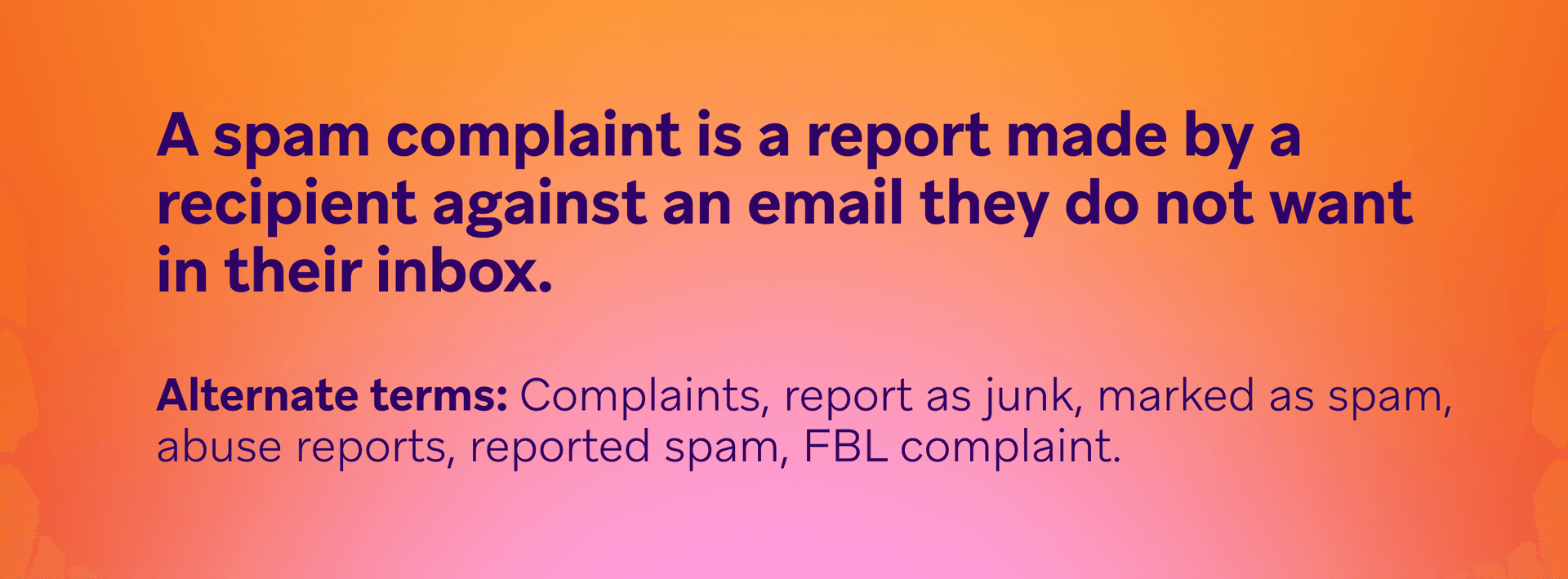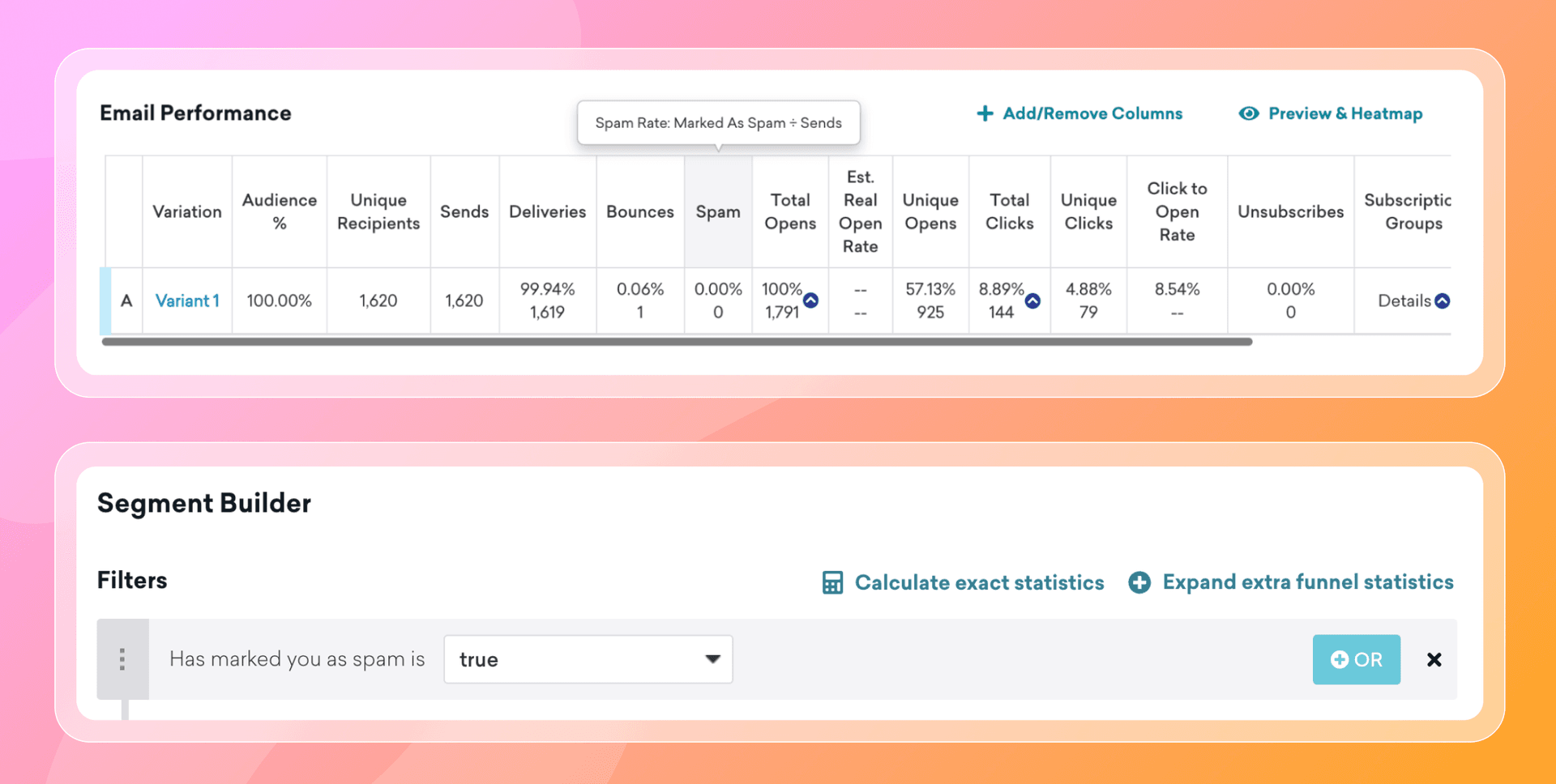Deliverability Indicators: Understanding Spam Complaints and What They Mean For Customer Engagement
Published on July 15, 2024/Last edited on July 15, 2024/8 min read


Lydia Vazquez
Senior Email Deliverability Consultant at BrazeHistorically, many users have found themselves frustrated by the massive volumes of unwanted messages promoting products, services, or scams that land in their inboxes. To manage this influx, users had to protect their own mailboxes by creating manual rules to filter out such content. As mailbox providers like AOL (now part of Yahoo) and Microsoft grew, they became prime targets for spammers or malicious content. In response, the development of spam filtering technologies began, initially relying on resources like reputation or blocklists to identify unwanted mail.
However, these measures weren’t enough. A significant advancement occurred in the early 2000s with the introduction of the complaint feedback loop (FBL). The FBL process enabled mailbox providers to relay user feedback directly to a sender. When a complaint report is received via FBL, the sender, whether an individual or their ESP, can then suppress the complaint address from the relevant mailing list(s) to ensure they don't receive further messages.
What are spam complaints?
A spam complaint is a report made by a recipient against an email they do not want in their inbox.
Alternate terms: Complaints, report as junk, marked as spam, abuse reports, reported spam, FBL complaint.

When someone receives an email they didn't sign up for or a message that they believe to be unwanted or irrelevant, they can mark it as spam through various avenues, such as clicking “report mail as spam or junk” in their email client, dragging the message into the spam folder, or reaching out directly to the organization's abuse desk administrator. The receiver, such as Yahoo or Microsoft, uses this feedback to refine their spam filtering algorithms, potentially preventing similar messages from reaching other users' inboxes. In short, spam complaints indicate to mailbox providers that mail is unwanted.
Keep in mind that a user can only report mail as spam if it lands in the inbox, including the promotions or focused tab. If an email is delivered to a user’s spam folder, that user will not have the opportunity to report mail as spam. Counterintuitively, this means that a lack of spam complaints can be a sign of deliverability trouble. If you’re seeing a 0% complaint rate (at mailbox providers other than Gmail or Apple—more to come on that below!), then your mail may already be hitting the spam folder.
Who submits spam complaints?
Anyone who receives an email in their inbox that they consider unsolicited, unwanted, irrelevant, or potentially harmful. They could be individuals, businesses, or other organizations.
Who receives spam complaints?
The complaints are received and processed by mailbox providers, email service providers, or organizations' abuse administrators.
Why do spam complaints happen?
The motivation behind spam complaints can vary, but they often stem from misaligned or unmet expectations, frustration, or genuine safety/security concerns. For instance, if it's difficult for a user to find your unsubscribe link and they want to stop receiving your emails, they might just report it as spam to avoid getting more emails. It helps to think of a spam complaint as a malformed unsubscribe request; the recipient wanted the mail to stop, and the “spam” button was the easiest or most trustworthy way to ensure the desired outcome.
When to worry about spam complaints?
As with most deliverability questions, it depends! Historically, the goal has always been to have no more than one spam complaint for every 1,000 emails sent. Recently, Gmail and Yahoo have suggested that senders aim for as few complaints as possible and never exceed 0.3%. While staying under these benchmarks may seem safe, a sudden spike can still happen. Mailbox providers can recognize an anomaly and see the complaints in relation to volume. Still, if it becomes a trend and you consistently exceed the threshold, it could be problematic and hurt your sending reputation over time.
Generally, it's important to pay attention to spam complaints as they can reveal a user experience story that might not otherwise be heard. Are there any specific campaigns that are receiving more spam complaints than others? Are your overall spam complaint numbers quite high? If you're noticing a lot of spam coming from your campaigns or overall, it's a good idea to investigate closely and figure out what's happening.
Even if your emails are not generating high rates of complaints, it's still a good idea to investigate them regularly: They can provide valuable insights into how your subscribers are viewing and interacting with your emails. Ultimately, it's important to ensure that you're sending relevant content to opted-in users at the frequency they would expect. Spam complaints are extremely damaging to your reputation, so it's crucial to treat them as a warning sign even if they haven’t yet had a noticeable impact on your deliverability.
Where to see your spam complaints
There are multiple ways for Braze customers to view spam complaints. Customers can see the spam complaints directly in the Braze dashboard under Campaign/Canvas Analytics and create a segment with the filter 'Has marked you as spam is true.' In addition, customers can use Currents to export spam complaints from Braze to their Data Warehouse and create Engagement Reports to get a CSV export of spam complaints.

It's important to note that not all mailbox providers offer complaint feedback loops, but Braze subscribes to most that do. The most notable providers that do not share spam complaint data are Gmail and Apple. This applies universally and is not exclusive to Braze; these providers simply prefer to keep that data to themselves. However, Gmail allows you to see an aggregate of your spam rate directly in Google Postmaster Tools, which is a great resource that can be accessed directly with Gmail or via the Braze Deliverability Center.
How do you prevent spam complaints?
First things first, make sure people actually want to hear from you by using permission-based subscription methods. Always ask for permission to send mail, as opposed to requiring it as part of another process. Using a double opt-in process is the best way to ensure list hygiene and engagement over the long term.
Another important measure is to include an unsubscribe link in every email so that unsubscribing is easier than reporting mail as spam. This may mean showcasing the unsubscribe link or preference center at the top of the message in addition to the footer, or even urging people to unsubscribe if they appear to be losing interest. You may be asking if unsubscribing hurts your sender reputation, too, and the answer is no. Unsubscribes do not carry the same penalty against a sender as spam complaints and can even help demonstrate trust.
We also recommend implementing a strong sunset policy based on email-specific engagement. After a certain amount of time has passed since a user last interacted with mail, send a re-engagement campaign or suppress them outright. This way, you will regularly filter out users who aren’t interested before they’re moved to complain.
Paying attention to feedback can also help you steer clear of any issues. With Braze Deliverability Services, you'll have an extra person on your team to monitor spam complaints and provide helpful, tailored guidance to combat them.
How to mitigate spam complaints
If spam complaints have harmed your sending reputation, you will likely notice that your emails are being delayed, sent to the spam folder, or even blocked. The response will differ from one mailbox provider to another. As a first step, look back and see if you had higher spam complaints before the change in performance. If so, then that is likely the cause of the shift in your results. Identifying the source of your spam complaints and taking steps to prevent them from happening moving forward is key. Did anything change before generating higher complaints? If nothing significant comes to light, then conducting an audit of your spam complaints would be best to shed some insight. This involves compiling a list of spam complaint addresses and reviewing their user histories to identify any common factors. Pay attention to where the users are in their subscription journey. For instance, if most users report emails as spam right after signing up, there might be an issue with the subscription process. Some senders find that spam complaints are not limited to one area and are occurring more widely. If that's the case, it's time to thoroughly review all practices to ensure they align with industry standards. Put yourself in your subscribers’ shoes and consider what their experience has been like since signing up.
Key Takeaway
While some senders may underestimate its impact, marking an email as spam is a strong signal that the message is unwanted or unexpected. Complaints play an integral role in the ongoing battle to combat unsolicited and dangerous mail. By flagging such messages, users signal to their mailbox provider or organization that certain senders or content is undesirable and should be filtered out of their inbox. It is important to dig into them whenever possible.
Check out the last edition of Deliverability Indicators, which are all about email blocklists!
Related Tags
Be Absolutely Engaging.™
Sign up for regular updates from Braze.
Related Content
View the Blog
How behavioral marketing turns data into personalized experiences

Team Braze

Experience optimization: Turning data insights into better journeys

Team Braze

December 2025 Bonfire Marketer of the Month: Jagex’s Emma Oliver
